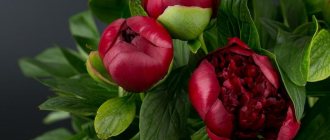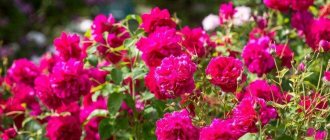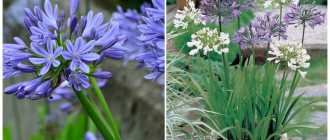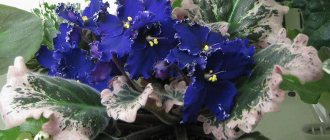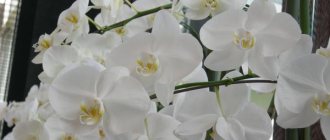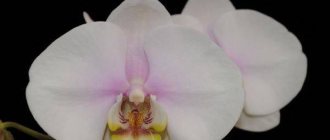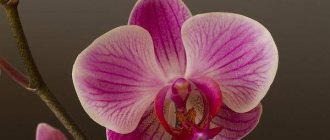Popularity of orchids for growing at home growing every year. And more and more flower growers are looking for rarer and more elite species.
Many people are interested in tiger orchids, namely, the names of specific orchid species. As Wikipedia kindly informed us, the group of tiger orchids includes the following:
- Elleanthus hymenophorus : native to the Neotropics.
- Grammatophyllum speciosum , native to southeast Asia.
- Maxillaria cucullata : native to the neotropics.
- Rossioglossum grande (aka Odontoglossum Grande): native to Central America.
They all have something of a tiger coloration, but judging by the number of photographs on the Internet, then most often the tiger orchid means Grammatophyllum speciosum, and it is its photographs that are often posted in articles on this topic.
Rossioglossum grande - photo and description of the species
In this article we will take a closer look at the last of the above list of “tiger” orchids - Rossioglossum major . This incredible plant has a number of features that set it apart from other orchids.
If they are not taken into account when growing at home, then at a minimum, you will have to wait a long time for flowering , and at maximum, the plant can be harmed or ruined. So how does the Tiger Rossioglossum ? Description of the variety and care at home will be described in detail in this article.
Rossioglossum grande in person.
How to propagate?
- Method 1. Consists of separating the basal baby. In the future, a new orchid may grow from it.
- Method 2. The baby is separated from the orchid peduncle. They can be found on dormant buds.
If your orchid has died, do not rush to throw it away. On its “stump” you can find 1-2 children, from which you can easily get a new plant. They easily accept separation and transplantation.
Short description
Rossioglossum grande was discovered in Guatemala in 1839 and named after John Ross. It is a close relative of odontoglossum. This amazing plant blooms with large, glossy flowers throughout the fall months. Vertical peduncles bear about six flowers. In the photo you can see what this incredible orchid looks like.
The plant itself is robust and robust with dark green foliage and large pseudobulbs. Currently, large Rossioglossum is rarely found in cultivation , which makes it even more desirable and exclusive. Interestingly, in its homeland, the plant is called “tiger’s mouth.” It is also listed as a protected species (II, CITES).
Available colors
Very bright and beautiful photo of Rossik.
Tiger orchid flowers
- Glossy;
- Bright yellow;
- Greenish with red-brown;
- A variegated pattern of spots and strokes on the petals.
Lip happens:
- White;
- Or creamy;
- Sometimes with brown spots.
Schilleriana: varieties and hybrids
There are three natural varieties of Schilleriana and more than 25 hybrid varieties:
- Var. Immaculata is distinguished by its almost white flowers with only a slight pinkish tint.
- Var. Purpurea has slightly larger flowers in rich pinks and purples.
- Var. Splendens has a brighter and more expressive marbled leaf color. The buds of this variety are large, in different shades of pink.
Var. Purpurea
Schilleriana hybrids and other species of the orchid family differ mainly in the size, shape and color of the buds. The most widespread are:
- Philadelphia (Phalaenopsis Philadelphia), which was obtained as a result of natural crossing of Schilleriana with Stuartiana (Phalaenopsis stuartiana). The white petals of this hybrid become pink closer to the center. They are classified as mini-orchids.
- Schillambo comes from Phalaenopsis Amboinensis, the petals have alternating white and orange stripes.
Other popular selections:
- Leucorrhoda is a cross with the Aphrodite variety (Phalaenopsis Aphrodite).
- Bon Soepardi - Schilleriana and Fringed Phalaenopsis (Phalaenopsis Fimbriata).
- Schillgig is a hybrid with Gigantea (Phalaenopsis Gigantea).
Phalaenopsis Philadelphia
Reviews
Pavel, Moscow: “ My collection was replenished with another copy a month ago. The plant came from a German nursery and cost a considerable amount of money. It’s not that I really need it, but when you start collecting different kinds of orchids in your house, it becomes very difficult to stop. Due to the fact that, together with the odontoglossum, they come from a similar area, I placed them nearby - this makes it easier to maintain the desired microclimate. It is worth noting that Rossioglossum has established itself as a demanding representative of the family. I think that I will be able to get it to bloom without much difficulty.”
Marina, St. Petersburg: “ In St. Petersburg, the summer was rainy, cloudy with little light and heat. But I really hope that this was enough for the dew, because I really want to see it bloom in person - I do what I can. I feed it once a month, it responds well to spraying and artificial lighting. Let's see what comes of all this."
Anatoly, Yekaterinburg: “ I was very lucky, because on a business trip I managed to get a blooming Rossioglossum. The flowers are simply stunning, you can’t take your eyes off them. The plant itself is strong and knocked down. Much stronger than I imagined. It can be seen that in nature it grows in rather difficult conditions and requires similar treatment. It is very important not to “fall him in love” with your care and create a similar extreme in the form of cool temperatures, changing seasons, humidity, etc.”
History of creation
Phalaenopsis Schiller first came to Europe a century and a half ago. The German orchid collector E. Schiller brought the flower from Portugal in 1860. This species was subsequently named in his honor and quickly gained popularity.
It is noteworthy that from the first batch, only one plant reached the Old World alive. Many flower growers dreamed of getting this orchid in their collection; soon Schilleriana received a scientific description and spread widely.
Botanical characteristics
The genus Rossioglossum is quite young in the orchid family. Six species of plants were bred in 1976 from the genus Odontoglossum. Three more species joined already in 2002. Like its relative odontoglossum, rossioglossum is a sympodial epiphyte, less often a medium-sized with a short root system.
Rossioglossum is a sympodial epiphyte, less often a lithophyte.
Pseudobulbs of this orchid:
- Large sizes;
- Egg-shaped;
- Flattened;
- Gathered in tight groups.
Attention! Pseudobulbs shrink and lose leaves with age, but remain plump. There is no need to remove them; these organs retain moisture in the tissues and serve as support for the younger generation of pseudobulbs.
Each bulb is up to 6 cm in height, bears from one to three leaves :
- Dense;
- Leathery;
- Lanceolate;
- Pointed;
- Dark green in color, sometimes with a bluish tint.
Leaf length is about 30 cm, width 3-5 cm.
Peduncles:
- Erect;
- Sturdy;
- They grow from the base of the pseudobulb.
The length of the peduncle is up to 25-30 cm, the inflorescence is a raceme that usually bears 6 flowers, but can grow up to 12 pieces.
An example of growing Rossioglossum in a pot.
The flowers themselves:
- Large;
- 10-15 cm in diameter;
- They open up gradually.
The petals of the flower are wide open , with a wavy edge and rounded or pointed tips. The color is yellow-red-brown, the pattern is similar to brindle.
Lip:
- Sedentary large;
- Fan-shaped;
- Three-lobed cream;
- Or brown;
- The column is pubescent.
Another large photo of Rossioglosum to illustrate the shape of the flowers.
What does a brassia orchid look like?
A sympodial plant of medium size (from 30–60 to 80–100 cm) with flattened spherical-ovate pseudobulbs, grooved, single-trifoliate, tightly seated on the rhizome, and longitudinal-lanceolate leaves.
Some species have flowers of various sizes - there are plants with both small corollas and quite large ones, collected in axillary inflorescences of up to 15 pieces, bloom in December or January and bloom for several months. The sepals are elongated and thin, droop freely, and can reach a length of about 15–20 cm; the petals follow their contour, but are slightly shorter.
The lip is large, widened towards the apex, sessile, fewer sepals and petals, the column is thickened and short. The corollas are painted in yellow-green-brownish shades, and the colors of the spots and the main background of the petals and sepals often change places - on a light brown background there is a yellowish-light green pattern, and vice versa, on the greenish-yellow sepals and petals there are stains, strokes and specks of chocolate-colored cherry color.
Features of flowering
Rossioglossum major blooms every nine to ten months, in the fall, around September-November. Flowering duration is 3-4 weeks, significantly reduced in hot conditions .
Stimulation
Rossioglossum is an extremely rare and demanding plant to care for. Stimulating the flowering of this orchid is far from the best solution .
In optimal growing conditions, Rossioglossum will bloom, but in unfavorable conditions, there is a significant risk of harming it or losing it.
Growing conditions and care
In nature, Rossioglossum most often lives on the trunks and branches of trees that grow in deciduous tropical forests from Mexico to Peru at altitudes of 1400-2600 meters. These areas are characterized by pronounced dry and wet periods of the year.
A characteristic feature of the wet period is:
- Large amounts of precipitation;
- And high clouds;
- As well as a limited amount of sunlight, which is filtered through clouds and tree leaves.
During the dry season, plants are exposed to cold temperatures and bright light as trees shed their leaves . There is little precipitation; orchids receive moisture only from fog and dew.
When growing Rossioglossum in culture, it should be provided with conditions for growth that are as similar as possible to natural ones .
Rossioglossum grande in a flask sells for $60.
Lighting
Rossioglossum, like its fellow odontoglossum, prefers moderate, diffuse lighting. However, make sure that your orchid is not left in the shade . It is best to place it a meter from the western or eastern window.
On the northern window you can place it on the windowsill , and on the southern window - in the back of the room. During hot summer afternoons, the plant must be shaded, otherwise there is a risk of sunburn.
It should be understood that in nature, Rossioglossums grow in low latitudes and require 12-14 hours of daylight. Therefore, for the winter it is necessary to acquire a lamp and artificially illuminate the plants .
Advice! A greenhouse or florarium will be the best place to grow your Rossioglossum.
Watering and humidity
Like odontoglossums, rossioglossums need to be watered approximately once or twice a week, depending on the weather. Care should be taken when watering. Use water :
- Soft;
- Seated;
- Or rain.
It is better to water:
- Along the edge of the pot;
- Or incomplete immersion.
The frequency of watering should be such that the substrate has time to dry completely. Pay attention to the growth of new pseudobulbs. Now Rossioglossum will need more moisture . During the dormant period, watering is reduced. Wrinkling of the pseudobulbs at this time is normal.
An example of a young plant.
Air humidity is preferable within 70-80%. Not lower than 40%, otherwise the Rossioglossum will dry out, and there will also be problems with the unfolding of new leaves . This is especially noticeable during the cold season, when central heating is turned on in apartments.
An increased level of humidity should be maintained by all available means. Place the pot in a bowl:
- With wet sphagnum;
- Expanded clay;
- Or pebbles.
Make sure that the bottom of the pot does not touch the water. Spray the plant itself with water in the morning :
- Seated;
- Rain;
- Or distilled.
Try not to let droplets from the spray bottle fall on the flowers - this can cause dark spots to appear on them. You can also purchase a humidifier to maintain humidity. The best solution would be to keep the plant in a florarium or greenhouse.
Temperature
Rossioglossums prefer cooler temperatures. In nature they grow :
- In the mountains;
- And cool forests.
The average daytime temperature during the growing season should be 22-25 °C, night temperature – 11-14 °C. During the rest period, temperatures are reduced to 20-21 °C and 9-10 °C, respectively. Obviously, temperature differences between day and night are necessary.
Large Rossioglossum is able to withstand short-term increases and decreases in temperature. Temperature extremes recorded in places of natural growth: 29.1 °C and 3 °C. However, it should be understood that these temperatures can be detrimental to flowers and the plant itself.
Advice! The circulation of fresh air, simulating natural conditions, will be beneficial for the orchid.
Feeding and fertilizer
Rossioglossums are fed with liquid mineral fertilizers for orchids in half the dosage indicated on the package. The frequency of feeding is once a month. It is unacceptable to feed the plant.
Immediately before fertilizing, it is necessary to moisten the roots of the plant , otherwise there is a risk of burning them. Once a month, dry the container with the flower to remove any remaining salt deposits. During flowering and during the dormant period, fertilizing is not carried out.
After flowering and during the dormant period
Immediately after flowering, Rossioglossum enters a rather long period of dormancy. A characteristic feature of this period is:
- Reduced humidity levels;
- Drought;
- And bright lighting.
These are the conditions that should be created for it when growing it at home or in a greenhouse.
Varieties of garden orchids
The following characteristics distinguish garden orchids from each other: planting - different varieties require different days for planting and different technologies, watering - some varieties do not tolerate excess moisture, others, on the contrary, prefer more water, reproduction - different conditions are created.
Kinds:
- Pollenhead is long-leaved or red. A type of outdoor orchid, it belongs to the monocotyledonous class. The plant is perennial, long-growing - capable of reaching 70 cm in height. It easily adapts to changing environmental conditions, so it grows in any area. The roots are strong, but easily susceptible to fungal diseases. The most common color is snow white. From the outside, the pollen head looks like a tall lily of the valley, but the buds are somewhat larger.
- Lyubka. The smallest orchid species of all. Small buds, located on the stem in large quantities, often have a greenish tint or boiling white with green veins. It prefers a humid environment, so in the wild it is often found in damp, swampy areas. Peculiarity of the flower: when it blooms throughout the summer, it emits a particularly strong aroma during rain and thunderstorms and at night. For this feature, Lyubka is often called “night violet”. The leaves seem to be divided into two parts. A variety that easily takes root in the northern and western regions.
- Cremastra Variable. It is difficult to care for this kind of plant. It requires constantly organized fertilization, regular watering and weeding, getting rid of pests and preventing their occurrence.
- Lady's slipper. The petals are usually found in a soft pink color, and the bud is painted in a bright fuchsia shade. It is often compared to unusual living butterflies and is easily confused from afar. This is a solitary flower, so it needs careful protection from pests.
Planting, transplanting and propagation
An example of a Rossioglossum transplant.
Rossioglossum large is an epiphyte. This means that the best solution is to mount it on a block or in a basket. When planting a plant in a pot, give preference to transparent species.
Use smaller containers and a medium or fine substrate - pine bark with the addition of sphagnum. Smaller pots are more practical, since the root system of Rossioglossum prefers close quarters .
It will be very useful to make holes in the pot to increase air circulation , ventilation and saturation of the root system with moisture from the air.
Planting a plant will not cause any difficulties :
- Fill the pot 1/3 full with substrate;
- Place the plant in the pot;
- Gently distribute the roots;
- Fill the remaining voids with substrate.
Rossioglossums are replanted only as needed , when the plant has grown out of its pot or when the substrate has become unusable and has lost its qualities. It is advisable to choose the time of transplantation after a period of rest, before the start of active growing season, so that the plant has time to recover and relieve stress.
During transplantation, dry and rotten roots are removed. At the same time, you can propagate your orchid. In culture, Rossioglossum is propagated vegetatively by dividing the bush. In this case, each plant should retain at least three pseudobulbs.
Some gardeners argue that two are enough, but three will still be better. Growing Rossioglossums from seeds in home culture is not practiced .
Place and soil
From the first days of this beauty’s appearance in the house, it is necessary to find a suitable place for her. To make it happy with regular flowering, it is recommended to place it on southern and eastern windows.
The key to successful orchid growth is properly composed soil. It should consist of:
All components are mixed. You can add a little peat to the composition. You can purchase ready-made soil for orchids. It contains everything necessary for the proper growth and development of the plant.
Main growing problems
An example of diseased roots of Rossioglossum.
Yellowish leaves mean the plant needs less light, while dark green leaves mean it needs more. The second factor that largely determines the health of a plant growing in an apartment is air humidity .
So, as temperatures increase, you should :
- Raise air humidity;
- And increase air circulation.
Make sure that air circulation does not turn into a draft. A draft can cause flowers and buds to drop. You should be especially careful in winter, when in apartments :
- Turn on the heating;
- And the temperature is rising;
- And the humidity drops.
Important! Be sure to provide the Rossioglossum with a sufficient period of rest, otherwise the orchid will not bloom.
Rotting of the root system is also dangerous for Rossioglossum . Flooding of the plant, the ensuing consequences and measures not taken to eliminate them can lead to the death of the orchid.
If it doesn't bloom
You may be interested in: Varieties of dill: list, description, cultivation features, photos
In order for the tiger orchid flower to delight you with abundant blooms, you must follow a few simple rules. To begin with, it is worth remembering that this plant is sensitive to movement. Therefore, the pot with it is not touched unless necessary. Orchids are delicate, whimsical flowers. Moving the pot from one edge of the window sill to the other has a painful effect on the plant. If you need to move the pot, then you should remember which side the light fell on. This side should be placed towards the light in a new place.
These flora specimens bloom at the age of one and a half years. Therefore, if a flower is not a year old, then you should not expect it to bloom.
When growing, you should pay attention to the root system. In order for the phalaenopsis tiger orchid to develop properly, you need to carefully monitor the root system.
Sometimes the plant refuses to produce a flower branch. To stimulate it, it is necessary to stress the plant by moving it to a cool place and stopping watering. After this, the plant releases a flower arrow and blooms.
Diseases and pests
is affected by :
- Spider mite;
- Mealybug;
- Shchitovka.
If a plant is damaged by insects, complex insecticides should be used in the dosage indicated on the package . Use fungicides to combat diseases, fungi and rot. If a plant is damaged by a viral infection, it is disposed of.
Prevention
The best prevention is:
- Maintaining plant health;
- And keeping him in normal conditions.
The healthier it is, the less likely it is to be affected by disease or insects.
What is a tiger orchid and how to care for it?
The orchid is a flower that is still gaining incredible popularity in many countries.
Tropical origin does not prevent collectors from obtaining such plants. Anyone considers the tiger orchid to be the highlight that will surely decorate any greenhouse. If such a flower is still not in the home greenhouse, then all the other plants are lost against each other. Tiger orchids have the ability to bring vibrancy and style back to everything around them.
